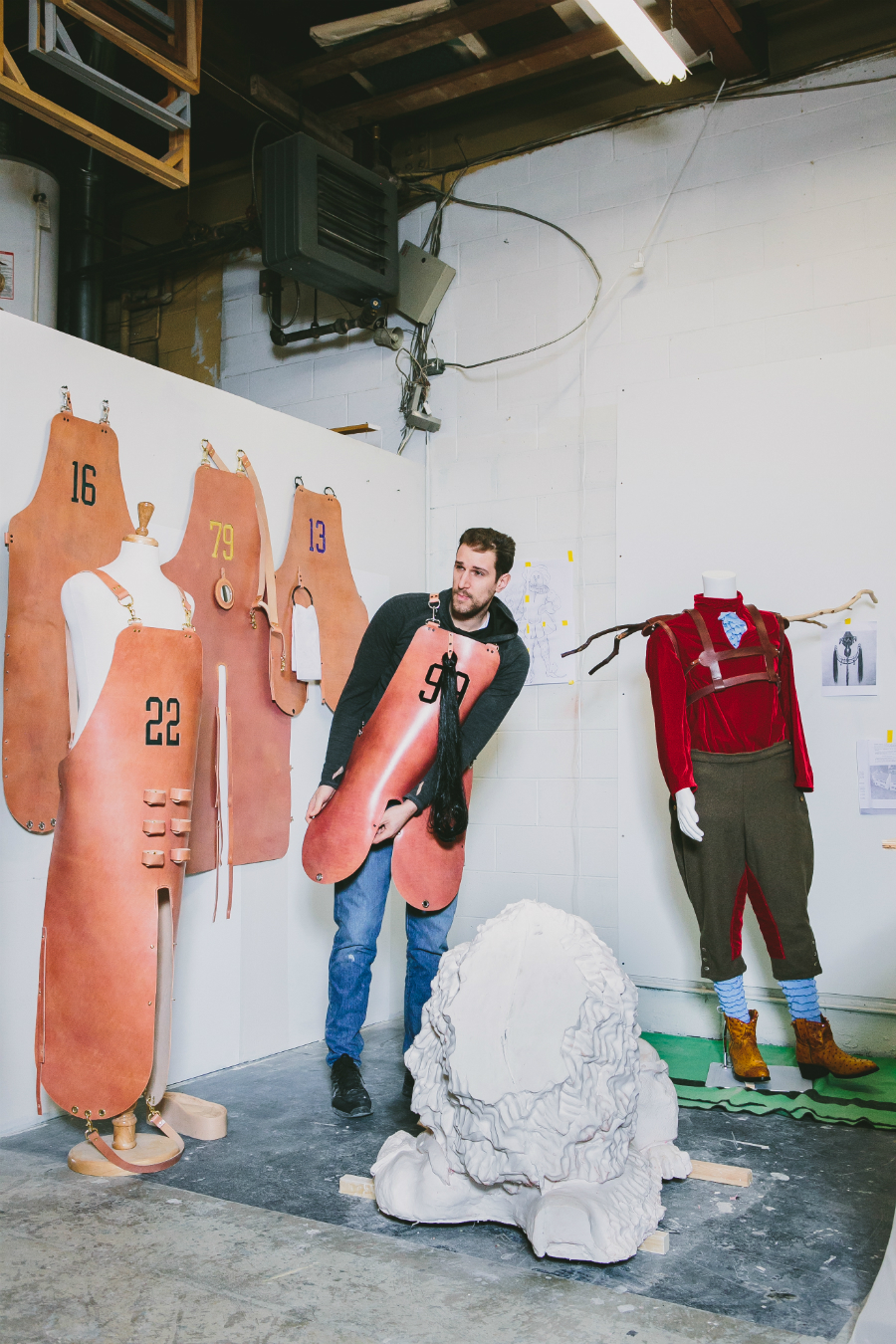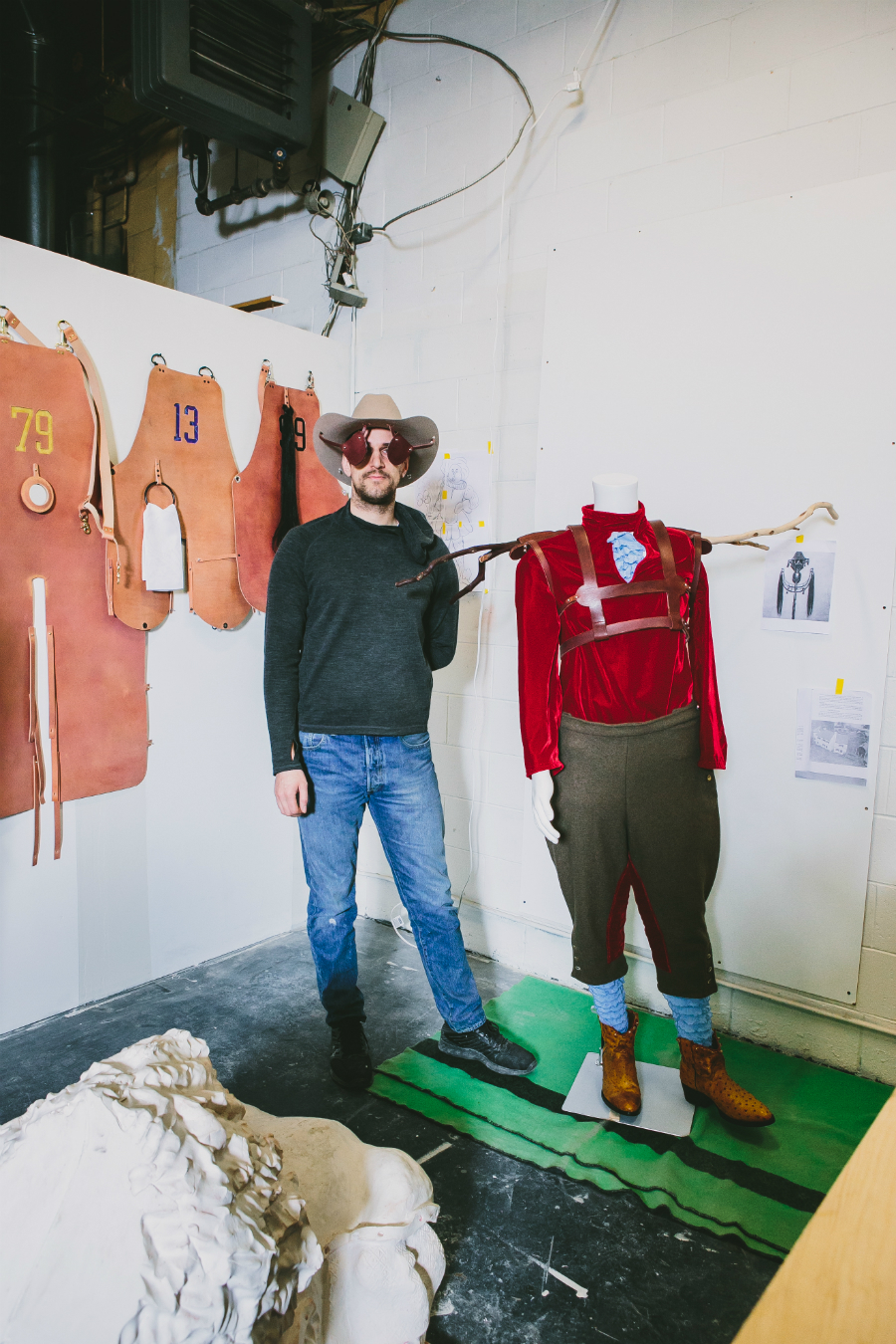Swaths of fabric; a mannequin dressed in velvet; heavy rolls of floral-embossed leather; style magazines strewn about. This is multi-disciplinary artist Mike Bourscheid’s East Vancouver studio, and its contents are that of a fashion atelier, a costume department, and a prop house combined.
Rather than the runway or stage, Bourscheid’s garments, objects, and sculptures are instead destined for the upcoming 2017 Venice Biennale. While Vancouver’s Geoffrey Farmer has garnered much of the attention as the Canadian representative for the May event, Bourscheid will be Vancouver’s other presence at the fair, representing his native Luxembourg. “Luxembourg is a pretty funny one because you have to apply for it,” Bourscheid explains of the selection process for Venice. “So there’s an open call.” Chosen by a board that includes representatives of Palais de Tokyo and Casino Luxembourg, the young artist is working hard on the pavilion—his most significant exhibition to date.
Bourscheid moved to Vancouver about five years ago after meeting his wife, Canadian sculptor Vanessa Brown, whose support has allowed him to work full-time as an artist. Some of his early works here made reference to his new home, such as Der Hammel von Kouver and Introducing myself to the Canada Geese. The latter had Bourscheid (poorly) mimicking the sounds of Canada geese with a homemade bagpipe, as potent schnapps dripped from his handmade mobile distillery. “I started with this bagpipe,” Bourscheid, who holds a master’s degree in fine art from the University of Arts Berlin, says in reference to his earlier work. “But then I found I was missing a costume. So that’s how I started to make costumes. I was always nervous, looking around for a costume, and I never found one until I started making them.”
Bourscheid’s work is primarily based around these get-ups and the characters they inspire. “It starts with a basic concept, often from a costume I want to make,” he says. “There will be maybe a movement that I want to do—I want to have something that restrains me, for example. Then, when I make the costume, the character starts to grow.” Personas that Bourscheid has constructed include The Goldbird Variations, which will be performed at the biennale. In the piece, the artist wears a golden cap, shirt, and skirt with a large vent tube protruding from the crotch. It brings together many themes common in Bourscheid’s work—gender performance, posturing, the amateur—presented with sincerity, the humour found in the earnestness of absurdity. Bourscheid cites his reference points for this performance as “Germany’s Next Topmodel, Austria’s Next Topmodel. Also, a lot of Westerns because they always have this macho posturing, which you never see in the streets, so you need somewhere to get that knowledge from.”
“I can pace people and play with their moods. And that’s the only thing I can do. I can’t speak for the people.”
Essential to these presentations is the acquirement of new talents. “I’m not a professional, trained sewer. So, you can see from works that I did before, that I have evolved in my skills,” he says. With each outfit, Bourscheid continues to develop his craftsmanship. There remains intrigue in the fumbles, uneven seams, and bunching groins, which help to break down the hard-line power structures that sometimes accompany performance. And with Venice quickly approaching, he is still incorporating even more abilities. “I’m doing a big pottery sculpture but I’ve never done pottery before, so I had to learn quite a bit,” Bourscheid laughs. “Now I go there every second day to just to pottery, throwing on the wheel. It’s kind of cool.”
For the biennale, Bourscheid’s exhibition will have to work within the unique constraints of Luxembourg’s venue. “It’s very special. The whole pavilion has an apartment feeling. It’s actually an old apartment,” he says. “I have a whole bunch of limits; I cannot do everything, which I kind of like.” Filling the six rooms of the apartment will be Bourscheid’s costumes that, when not activated by performance (which the artist will be doing throughout the biennale), become sculptures. “They’re often furniture-like, more of an abstract form,” he explains, scoffing at the idea of using mannequins.
The biennale offers one of the largest and most diverse audiences available to any artist. Bourscheid, who has yet to have any major solo exhibitions or international exposure, is at a unique crux in his career. And, as with all art, the interpretation of his work is now left wide open to this new stage. “I can pace people and play with their moods. And that’s the only thing I can do. I can’t speak for the people,” he reflects. “That’s the weird part of being an artist; I can only speak for myself, but you can create dialogue.” And after the curtains close in Venice, there will be plenty to talk about.
More from our Arts section.










